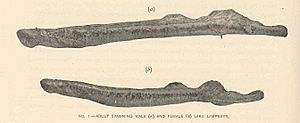Lake lamprey facts for kids
Quick facts for kids Lake lamprey |
|
|---|---|
 |
|
| (A) Spawning male and (B) Spawning female | |
| Conservation status | |
| Scientific classification | |
| Synonyms | |
|
The lake lamprey, also known as the Vancouver lamprey or Cowichan lamprey, is a special type of freshwater lamprey. It lives only in two lakes in Vancouver Island, Canada: Lake Cowichan and Mesachie Lake. This lamprey is a close relative of the pacific lamprey. It was first identified in the 1980s.
Contents
What Does the Lake Lamprey Look Like?
An adult lake lamprey has a dark blue or dark brown body. Its belly is usually lighter in color. These lampreys can grow to be about 11.8 to 27.3 centimeters long.
The lamprey has a round, disc-like mouth. This mouth is full of sharp teeth. The Vancouver lamprey also has eyes on the top of its head. It has two fins on its back, a tail fin, and another fin underneath its body.
Where Do Lake Lampreys Live?
The lake lamprey is found only in Lake Cowichan and Mesachie Lake. Both lakes are on Vancouver Island. Unlike some other lampreys, these lampreys do not travel to the ocean. They stay in their freshwater lakes.
Lake lampreys live and lay their eggs in shallow, rocky areas. They usually stay in the lake and do not go into streams. Young lampreys, called ammocoetes (am-oh-SEE-tees) larvae, live in the soft mud along the lake shores. Scientists have found that these lampreys could survive in saltwater. However, in nature, they always stay in fresh water. It is thought that only about 1,000 to 2,000 adult lake lampreys live in both lakes combined.
What Do Lake Lampreys Eat?
Adult lake lampreys are predators. They attach themselves to other fish species. They feed on the body fluids of these fish. Young salmon are common prey for them. This includes fish like cutthroat trout and coho salmon.
Sometimes, the lamprey's feeding can make deep wounds on the host fish. However, most fish only get scars. They are usually not killed by the lamprey. Only about 15% of fish that are fed on die from the injuries. Lampreys are one of the main predators of salmon in these lakes. Many salmon (50-80%) found in the lakes have scars from lamprey feedings.
Lake Lamprey Life Cycle
Lake lampreys breed only once in their lives. This usually happens when they are about 8 years old. They lay their eggs from May to August. They choose shallow, rocky areas in the lake or the mouths of small creeks.
A female lamprey can produce over 10,000 eggs in 2 to 3 weeks. The young lamprey larvae, called ammocoetes, live in soft mud or sand where the water is calm. They eat tiny bits of organic material. These larvae live for 5 to 6 years. Then, they change into adult lampreys through a process called metamorphosis. Adult lampreys live for only about 2 more years. After this, they return to the lake shores to lay their own eggs.
Images for kids



